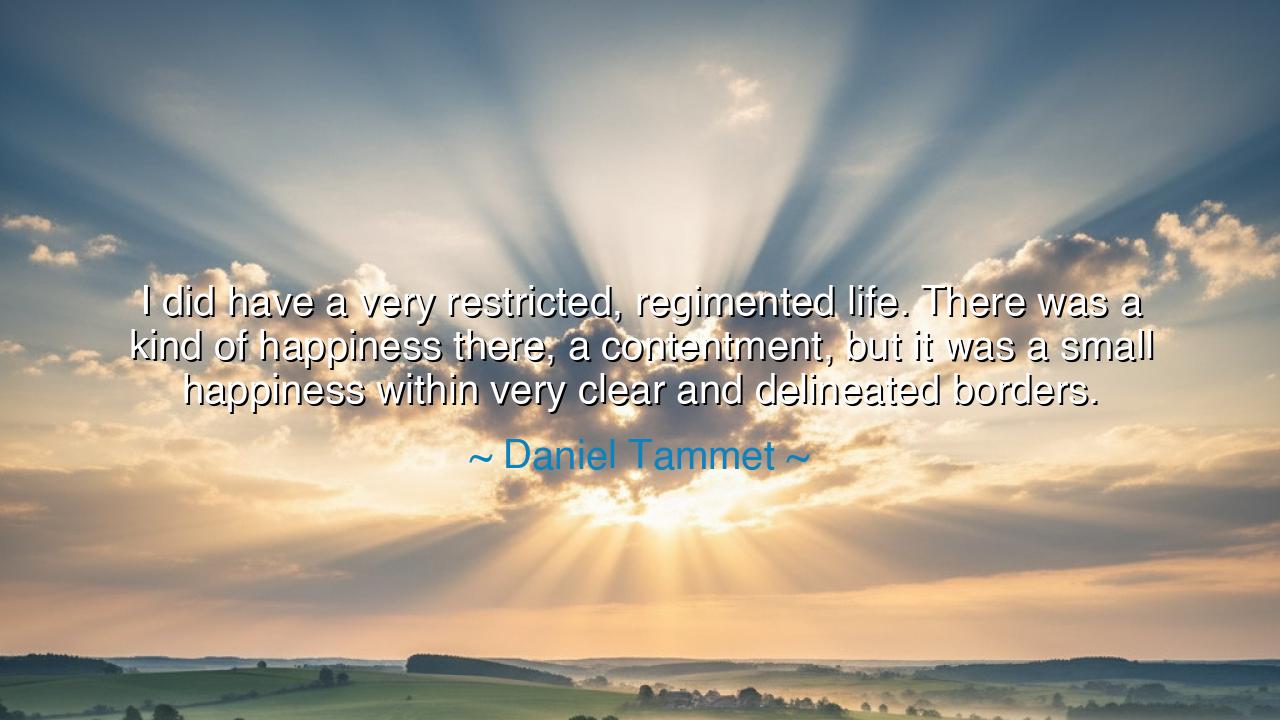
I did have a very restricted, regimented life. There was a kind
I did have a very restricted, regimented life. There was a kind of happiness there, a contentment, but it was a small happiness within very clear and delineated borders.






When Daniel Tammet said, “I did have a very restricted, regimented life. There was a kind of happiness there, a contentment, but it was a small happiness within very clear and delineated borders,” he spoke as one who has looked deeply into the nature of human fulfillment. His words are not the complaint of one who felt confined, but the reflection of one who has learned the delicate balance between order and freedom, between the comfort of structure and the vastness of possibility. In this quote, Tammet—known for his extraordinary mind and unique way of perceiving the world—teaches us that happiness can exist even in limitation, but it is often a contained happiness, bound by the fences we build to protect ourselves from the unknown. It is a peace that soothes but does not soar.
The origin of this reflection lies in Tammet’s early life, shaped by autism and savant syndrome, through which he experienced the world in patterns, numbers, and precise routines. His life, as he describes it, was a mosaic of order—each day arranged with mathematical exactness, each thought structured in perfect rhythm. Within those limits, he found a quiet kind of contentment, a world that made sense, safe from chaos. Yet as he grew older and began to step beyond those familiar borders, he discovered that beyond safety lay wonder—that the human spirit, though it seeks structure, was born to wander. His statement, then, is not only a memory but a meditation on what it means to live both within and beyond one’s boundaries.
There is a profound paradox here: that structure brings peace, while freedom brings growth. Many throughout history have faced this same struggle—the desire to remain in the comfort of the known versus the call to explore the unknown. The philosopher Plato spoke of prisoners in a cave who found contentment watching the shadows on the wall, mistaking them for reality. They were happy, but their happiness was small, for it existed within “clear and delineated borders.” Only when one prisoner escaped and saw the vastness of the sunlit world did he understand the cost of his earlier contentment. Likewise, Tammet’s insight reminds us that there is a kind of happiness that soothes the heart—but another, far greater happiness that challenges and transforms it.
Yet we must not scorn the happiness found in structure. There is beauty in discipline, in the daily rituals that bring calm to the storm of life. Consider the monks of old who lived behind monastery walls, bound by vows of silence and simplicity. Their days were regimented by bells and prayers, their movements choreographed by devotion. To outsiders, their world may have seemed narrow, yet within those borders, they found tranquility and a sense of divine purpose. Tammet’s “small happiness” was not false—it was real, but it was peace without flight, joy without risk. Such contentment has its place in the human heart, especially in times when the world feels too wide and overwhelming.
However, there comes a moment when the soul begins to thirst for something more. A life too tightly ordered can become a cage; a happiness too contained can begin to feel like sleep. Tammet’s later life, filled with learning, travel, and connection, shows that he did not remain within his early confines. He stepped beyond them—not to destroy his order, but to expand it. He discovered that the greatest happiness lies not in rejecting structure, but in choosing it freely, and in knowing when to open its gates. His journey mirrors the truth that every human being must face: that safety is precious, but growth requires courage; that the walls that once protected us must one day be opened so that we may breathe.
This wisdom finds echo in the story of Helen Keller, who, born blind and deaf, lived in a world bounded by silence and darkness. When her teacher, Anne Sullivan, entered her life, those boundaries began to shift. At first, Helen resisted—her regimented world was all she knew—but when she finally grasped the concept of language, the borders of her life exploded into infinity. She later said, “Life is either a daring adventure or nothing at all.” In her awakening, we see Tammet’s same journey from contained contentment to boundless discovery—a transformation from peace to purpose, from stillness to song.
So, my children of the present age, hear this teaching: there is no shame in small happiness, but there is danger in never reaching beyond it. The walls of order and comfort are necessary, for they give us strength and grounding—but they are not meant to hold us forever. Begin within your borders, but do not let them define you. Let routine teach you discipline, but let curiosity lead you toward wonder. For as Daniel Tammet teaches, happiness within limits is peace—but happiness beyond them is freedom. Walk first within your circle, then step gently beyond it, and you will find that the truest joy is not in safety or risk alone, but in the dance between the two—the balance of structure and flight, of contentment and the infinite call of the open sky.






AAdministratorAdministrator
Welcome, honored guests. Please leave a comment, we will respond soon